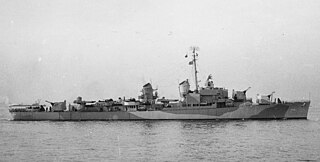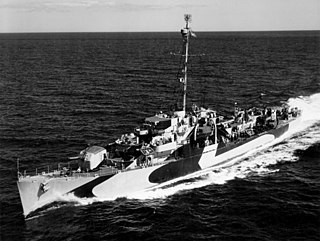
USS Arnold J. Isbell (DD-869), a Gearing-class destroyer, was the only ship of the United States Navy to be named for Arnold J. Isbell, an aircraft carrier captain during World War II. The ship was laid down on 14 March 1945 at Staten Island, New York, by Bethlehem Mariners Harbor, launched on 6 August 1945 and commissioned on 5 January 1946. Constructed too late to see action in World War II, the vessel initially served as a training ship with the United States Atlantic Fleet, before transferring to the Pacific and deploying to Korea during the Korean War and off the Vietnam coast during the Vietnam War. In 1972 Arnold J. Isbell was made part of the reserve training fleet and in 1974, sold to Greece where the ship was renamed Satchouris and served with the Hellenic Navy until being sold for scrap in 2002.

USS Brinkley Bass (DD-887) was a Gearing-class destroyer in service with the United States Navy from 1945 to 1973. She was then transferred to Brazil where she served as Mariz e Barros (D-26) until 1997. The destroyer was finally sunk as a target in 2000.

USS Hopewell (DD-681) was a Fletcher-class destroyer in service the United States Navy from 1943 to 1947 and from 1951 to 1970. She was finally sunk as a target in 1972.

USS McGinty (DE-365) was a John C. Butler-class destroyer escort of the United States Navy.

USS Conway (DD/DDE-507), a Fletcher-class destroyer, was the second ship of the United States Navy to be named for William Conway, who distinguished himself during the Civil War.

USS Charles S. Sperry (DD-697) was an Allen M. Sumner-class destroyer in service with the United States Navy from 1944 to 1973. In 1974, she was sold to Chile, where she served as Ministro Zenteno (D-16). She was finally scrapped in 1990.

USS Purdy (DD-734), was an Allen M. Sumner-class destroyer of the United States Navy.

USS Alfred A. Cunningham (DD-752), an Allen M. Sumner-class destroyer, is the only ship of the United States Navy to be named for Alfred Austell Cunningham, a USMC officer and aviator.

USS John R. Pierce (DD-753), an Allen M. Sumner-class destroyer, is the only ship of the United States Navy to be named for Lieutenant Commander John Reeves Pierce.

USS John A. Bole (DD-755), was an Allen M. Sumner-class destroyer of the United States Navy.

USS John W. Thomason (DD-760), an Allen M. Sumner-class destroyer, is the only ship of the United States Navy to be named for John William Thomason, Jr., a USMC officer who was awarded the Navy Cross for bravery during World War I.

USS Marsh (DE-699) was a Buckley-class destroyer escort of the United States Navy.

USS Walton (DE-361) was a John C. Butler-class destroyer escort in the United States Navy. It was named after Merrit Cecil Walton, a Marine Corps platoon sergeant with the U.S. 1st Marine Division, who died on Gavutu during the Battle of Guadalcanal and was posthumously awarded the Navy Cross for "extraordinary heroism".

USS Herbert J. Thomas (DD-833) was a Gearing-class destroyer of the United States Navy.

USS Wiltsie (DD-716) was a Gearing-class destroyer in the United States Navy. She was named for Irving Wiltsie. The destroyer entered service in 1946 and remained active with the United States Navy until 1977, when Wiltsie was decommissioned and sold to Pakistan in 1977. The vessel entered service with the Pakistan Navy as PNS Tariq (D165) in 1978. In 1990, the ship was renamed PNS Nazim to allow the name Tariq to be given to a newly-acquired Type 21 frigate. The ship was then transferred to the Pakistan Maritime Security Agency and used as an alongside "at sea" headquarters for the agency. Though afloat, the vessel no longer sails.

USS McCoy Reynolds (DE-440) was a John C. Butler-class destroyer escort acquired by the U.S. Navy during World War II. The primary purpose of the destroyer escort was to escort and protect ships in convoy, in addition to other tasks as assigned, such as patrol or radar picket. Post-war, after operating in the Pacific Ocean battle areas, her crew members returned home with four battle stars to their credit for World War II and one for the Korean War.

USS William Seiverling (DE-441) was a John C. Butler-class destroyer escort acquired by the United States Navy during World War II. The primary purpose of the destroyer escort was to escort and protect ships in convoy, in addition to other tasks as assigned, such as patrol or radar picket. Post-war she returned home bearing four battle stars; when she was reactivated for the Korean War, she returned home after that war with three more.

USS Ulvert M. Moore (DE-442) was a John C. Butler-class destroyer escort acquired by the U.S. Navy during World War II. The primary purpose of the destroyer escort was to escort and protect ships in convoy, in addition to other tasks as assigned, such as patrol or radar picket. Post-war she returned home bearing five battle stars; when she was reactivated for the Korean War, she returned home after that war with three more.

USS Silverstein (DE-534) was a John C. Butler-class destroyer escort in service with the United States Navy from 1944 to 1947 and from 1951 to 1958. She was sold for scrapping in 1973.

USS Lewis (DE-535) was a John C. Butler-class destroyer escort in service with the United States Navy from 1944 to 1946 and from 1952 to 1960. She was finally sunk as a target in 1966.





















